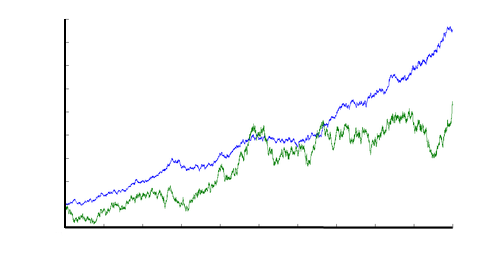The Black-Scholes calculator computes the values for Call and/or Put options using various currencies.
INSTRUCTIONS: Enter the following:
- (CP) Chose whether it's a Call or Put (see definition below)
- (S) Enter the stock or spot price.
- (X) Enter the strike price
- (T) Enter the number of years to maturity
- (v) Enter the percent of volatility
- (r) Enter the risk-free rate
Call or Put Value (CPV): The calculator returns the prescribed call or put value in U.S. dollars (USD). However, the user can automatically convert this to other currency units via the pull-down menu including European Euro, Canadian Dollar, Mexican Peso, Brazilian Real, Russian Rubel, Indian Rupee, Chinese Yuan, Japanese Yen, Swiss Franc, Australian Dollar and the South African Rand,
Description
The Black-Scholes equation is based on a partial differential equation that was developed as a model of the financial market. A Wikipedia article on the Black-Scholes equation can be found HERE. This equation is a useful approximation to determine the benefit of purchasing the option and has been tested against two of the algorithms found at espenhaug.org (HERE. However, users should independently confirm their calculations before relying on this or any other equation to make financial decisions.
APPLICATIONS
The Black–Scholes equation, a partial differential equation, gives a theoretical estimate of the price of European-style options over time. The Black-Scholes equation employs the technique of constructing a risk neutral portfolio that replicates the returns of holding an option and produces a closed-form solution for a European option's theoretical price at maturity.

NOTES
OPTIONS TERMINOLOGY
- option - a contract which gives the buyer (the owner and investor) the right, but not the obligation, to buy or sell an underlying asset or instrument at a specified strike price on or before a specified date. The option specified the following terms:
- the number of stocks, usually in denominations of 100 shares per contract
- the expiration date specifying when the option expires
- the contract style specifying that an investor will exercise an option any time before the maturity date or will exercise the option only on the expiration date
- call option - an option which conveys to the owner the right to buy something at a specific price
- put option - an option which conveys the right of the owner to sell something at a specific price
- strike price - the strike price, also known as the exercise price, is the price at which the underlying contract will be exercise (carried out). The strike price for a call option is the price at which the buyer can buy a security or commodity. The strike price for a put option is the price they can sell a security or commodity.
- riskless rate or risk-free interest rate - the rate specified in the option for a given stable asset in the Black-Scholes model. The model assumes a money market, cash or bond exists that that has a rate of return that is constant.
- time to maturity, T - the option specified time after which the options contract expires.
The Black-Scholes EQUATION
The value of a call option for a non-dividend-paying stock exercised after the specified time, T, is given:
Call Value = N(d1)⋅S-N(d2)⋅X⋅e-r⋅T
The value of a put option based on put-call parity is given
Put Value = X⋅e-r⋅T-S⋅Call Value = N(-d2)⋅X⋅e-r⋅T-N(-d1)⋅S
where d1 and d2 are given as:
d1 = 1v⋅√T⋅[ln(SX)+(r+v22)⋅T] and
d2 = d1-v⋅√T
For these equations:
- N(d1) and N(d2) are the standard normal cumulative distribution functions for d1 and d2 respectively
- T is the time to maturity of the option
- S is the spot price of the asset
- X is the strike price
- r is the risk free rate
- v is the volatility of the return from the asset
LIMITATIONS OF THE MODEL
- The Black-Scholes formula has only one parameter that cannot be observed in the market: the average future volatility of the underlying asset. Since the formula is increasing in this parameter, it can be inverted to produce a "volatility surface" that is then used to calibrate other models.
- One key assumption made by the Black-Scholes model is that volatility is constant. Even if the Black-Scholes model results may not completely accurate, they can still serve as a first approximation. More refined models have been built to address each of the Black-Scholes model limitations.
- Another limitation cited is that the risk-free interest rate is not actually known, and is not constant over time.
Before using the Black-Scholes equation for your own estimations, you should read the following article: http://www.theguardian.com/science/2012/feb/12/black-scholes-equation-credit-crunch. This article takes a look at what caused the 1987 banking debacle and suggests that it was caused by the misuse of the Black-Scholes formula. Pay particular attention to the mention of the bestseller The Black Swan by Nassim Nicholas Taleb. This book looks at the natural phenomena of how extreme events cause even the most robust estimation theory to fail, which is important to remember when doing estimates for investment purposes.
ORIGINAL PUBLICATION
Robert C. Merton was the first to publish a paper expanding the mathematical understanding of the options pricing model. He coined the term "Black–Scholes options pricing model". Merton and Scholes received the 1997 Nobel Prize in Economics for their work. Though ineligible for the prize because of his death in 1995, Black was mentioned as a contributor by the Swedish Academy.